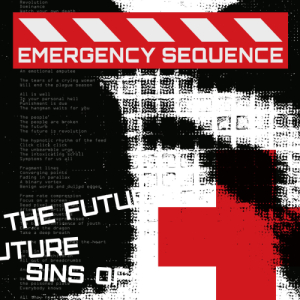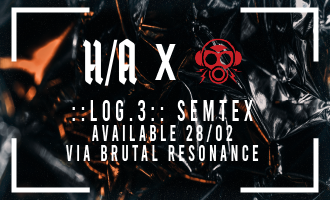Emergency Sequence - Sins of the Future

This review was commissioned. However, it bears no weight on the score or decision. All reviews are written from an unbiased standpoint.
Every couple of months that pass by I swear that Mirland’s name pops up somewhere anew. The celebrated producer does not commit to downtime and perhaps never sleeps in a never-ending spell of musical creation. The last time I heard his name pop up was when he dedicated himself to Emergency Sequence, a new-ish project featuring both himself and Bryon Wilson. Time passed and they released their first well-received single ‘1938’ and went on to appear on Laebel’s compilation “Fulfillment Compilation Volume 1”. A little bit more time was passed, files were sent back and cross oceans in cyberspace, and thus they gave birth to their debut album “Sins Of The Future”. This little callback to EBM and electro-industrial succeeds in most areas, though flaws in repetition and vocals keep it back from earning a higher score.
Now, you might be wondering to yourself how the fuck can production be good and yet the beats be stale? Well, young man, I will tell you. I’ve no complaints in the mixing and master department; the songs are quite well made with every electronic trickle able to sneak up my spine. This is apparent from the get go with ‘Deep Flaw’ and ‘Failure to Load’ but continues to spread out to bass heavier songs such as ‘Perpetual Grind’. It is a half-and-half issue in EBM for producers to allow their bass to overpower everything else in the mix; this does not happen with Emergency Sequence.
Where they succeed in that department they fail in keeping a song interesting for an extended period of time. Take a look at track number two, for example, ‘Failure To Load’. It starts off with an enticing EBM beat, almost minimal, before opening up with some distorted, almost-whispered vox. But from there it is a recipe in repetition where the bassline stays practically the same for three-and-a-half minutes. Sure, other textures and samples join the fray to offer some differentiation here and there, but the same bit is repeated for three-and-a-half minutes with no breaks. There should be some sort of switch every minute or minute and a half to keep a song entertaining and refreshing; I got none of that here.
This is not a constant issue, however, as seen on tracks such as ‘Pressure’. This is a four-minute and fifty-one-second-long song but it does not feel like it. And that’s simply because Emergency Sequence put a bit more thought into the composition and how it plays. The beginning starts with echoing electronic blips, as if you’ve just discovered an alien spaceship that’s been lost in an underground cavern for quite some time. Slowly, this ambiance transforms into a semblance of a rhythm before Emergency Sequence unleashes their beat around the one-minute mark. Furthering the song comes digitized vocals. A minute of that then transfers into a small breakdown around the two-minute and thirty-eight second mark before the beat comes back much punchier. So on and so forth; this is what I’d like to see more of from Emergency Sequence moving into the future.
A bane of industrial music’s existence is often times the vocals and the same can be said for Emergency Sequence. While it’s clear that neither member is naturally born to be the next Celine Dion, they put on enough of a façade through digital assets to make their vocals bearable – in most cases. Coming back to one of the punchier songs on the album, ‘Perpetual Grind’, I thought that the vocals were quite awful. Perhaps the monotone, soulless delivery was intentional to match the mechanical grind of the album, but goddam did it take down the otherwise hardened rhythm of the track. The vocals are much more palpable when they are further digitized and made robotic a la ‘1938’. More spoken word than sung, but with just enough rhythm that it matches the synthetic beauty of the track. That is what I like to hear.
I feel as if “Sins of the Future” is a good album but one that probably could have spent a bit more time being worked on and touched up before being sent out to the masses. There could have been a chopping block routine of getting rid of weaker songs in place of the stronger ones – the whole quality versus quantity thing. But when Emergency Sequence gets everything right, they turn out some fantastic bangers that’ll get the dancefloor lit up in no time.

Steven Gullotta
info@brutalresonance.comI've been writing for Brutal Resonance since November of 2012 and now serve as the editor-in-chief. I love the dark electronic underground and usually have too much to listen to at once but I love it. I am also an editor at Aggressive Deprivation, a digital/physical magazine since March of 2016. I support the scene as much as I can from my humble laptop.
Share this review
Facebook
Twitter
Google+
Shares
Buy this release
Bandcamp
Neoklin - In Motion is available at POPONAUT from 14,45€
Related articles
VHS Glitch - 'Demoniac'
Review, Oct 30 2016
Everything Goes Cold - 'The Tyrant Sun'
Review, Mar 25 2012
Ritualz - '†‡†'
Review, Apr 24 2021
Josie Pace
Interview, May 24 2022
Benjamin'sPlague - 'MINIVIEW: Choke On Euphoria'
Review, Oct 22 2015



